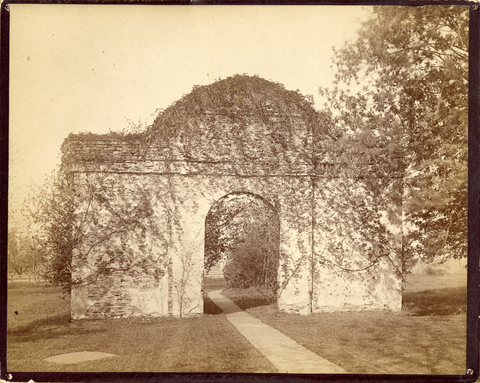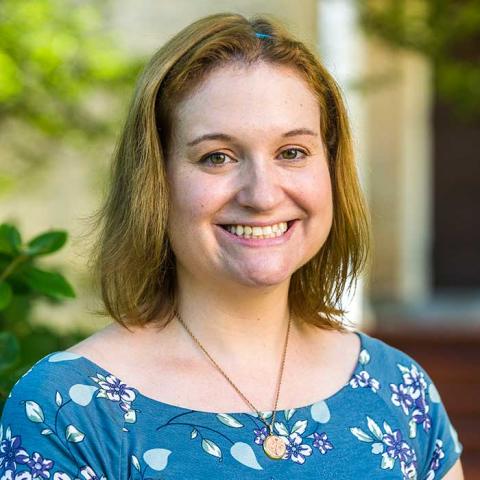Beyond the Arch: William Carvill, Haverford’s First Landscape Architect

Photograph of the Carvill Arch taken by Henry Herbert Goddard circa 1886. The arch is the remnant of a greenhouse that burned down in 1855.
Details
In this post, Cullen Worth '27 explores English gardener William Carvill's relationship with the College. Cullen worked as the Quaker & Special Collections Liaison Intern during Summer 2024.
Only a short walk from the Dining Center and sandwiched between the modern wing of Lutnick Library and the Morris Infirmary, sits an unremarkable stone arch. Many would mistakenly assume it to be mere ornamentation, just another scenic backdrop on a campus full of them; however, a closer look reveals a small bronze plaque bearing the inscription “Carvill’s Arch.” Some Haverford students, particularly those attentive during their extensive Customs training, could tell you that this arch is the only remaining ruin of an older, greenhouse structure; fewer can remember the name William Carvill, whom the arch is named after. Despite his memorial serving as a landmark on the Haverford campus, little is known about Haverford’s first gardener. Typically, in these instances, a curious historian may consult A History of Haverford College for the First Sixty Years of Its Existence, a remarkably useful book even in the age of limitless information via the internet. Unfortunately, mentions of Carvill are few and far between, generally amounting to off-handed praise for his contributions to campus beautification, or a tangential cricket tale of dubious reliability. Searching deeper in the College Archives reveals a plethora of material, both produced by Carvill and created by others. These manuscript materials produce a timeline of Carvill’s tenure at Haverford – from his beginnings as an English transplant, to his eventual fate as a squatter on the abandoned campus.
William Carvill was hired between 1833-34 to transform the rolling meadows and land of Llewellyn’s farm into the campus landscape recognizable to current Haverford students. Carvill concentrated his efforts on planting trees across the once-wooded tract in hopes of reintroducing native flora and fauna to the clear-cut fields. Orchards of apple, plum, peach and pear trees were established, serving both the newly admitted students and cattle (holdovers from the now-defunct farm). Carvill’s original planting diagram called for three, parallel roads lined with regularly spaced trees and grand, European-inspired lawns, punctuated by the occasional tree circle. Featherbeds and a greenhouse were positioned to the west of Founder’s Hall, while the grounds to the east were left undeveloped. Pathways and a single lane meandered across unbroken fields, guiding travelers to the school’s only entry-point via Haverford Road. While not an architect by trade, Carvill reportedly aided in the construction of Haverford’s second greenhouse in 1838. Carvill’s vision for the campus, though rudimentary, laid the foundation for subsequent additions and remains largely intact to this day.
Apart from his landscape contributions, one will also find mention of William Carvill throughout the history of Haverford’s cricket team. An Englishman by birth, Carvill was an avid cricketer and brought along his beloved hobby as he immigrated across the Atlantic. Legend has it that he taught a group of students to play on Founder’s lawn in 1833, though this claim (primarily the year) has been disputed. Despite this, it is widely accepted that Carvill pushed for cricket’s adoption during his tenure and remained indirectly involved with the team long after he left the school in 1845. According to the 1892 History of Haverford College, Carvill (at the age of 84) was in attendance at the 1878 Germantown match between Haverford and the University of Pennsylvania.
By the early 1840s, Haverford’s early success began to slow. Though the school was never intended to be a particularly lucrative investment for shareholders, it proved unable to break even financially as expenses quickly surpassed revenue. Despite donations from Friends, investors and teachers, the financial situation proved too dire for recovery, forcing the Board of Managers to close the school indefinitely upon the completion of the 1845 summer term. All faculty and staff were let go, leaving the campus in a state of limbo and, at least on paper, abandoned.
As early as 1840, amidst a worsening financial situation, Carvill’s continued employment was called into question. An agreement was reached which extended his contract with the school for two years, terminating in April, 1842; however, this would be altered twice to employ Carvill through April of 1845 on a year-to-year basis. Notably, these extensions altered the terms of his employment by offering Carvill a cottage and food in place of some of his salary. This was suggested as a win-win for both Carvill and the Board of Managers, but had the unforeseen consequence of pushing Carvill to be dangerously reliant on a struggling institution.
On March 28, 1845, Jonathan Richards (a founder and principal at the Haverford School) received a letter from Thomas P. Cope (an alum of the same institution) concerning the continued presence of William Carvill on the soon-to-be abandoned campus. Carvill had allegedly refused to vacate his college-owned house and Cope feared that his squatting could result in claims of unpaid wages or blatant property theft. While a definitive motivation is never mentioned, it is likely that Carvill was acting out of necessity, rather than petty revenge. Seven years earlier, Thomas Pim Cope – then a student at the Haverford School – sent a letter to his mother containing details about his semester. He mentions the upcoming completion of the greenhouse and compliments Carvill on his exemplary work, but confesses “how he is going to be paid for it I do not know, and I doubt that anybody does.” It is possible that Carvill incorrectly assumed that his contract would be renewed for another year, as it had been since 1845, and upon finding out otherwise, was left with few options. Without family in the U.S. to call upon for support, he likely saw staying in the cottage as his only option while he searched for alternative housing. There is no record of how long Carvill remained in his residence, only a final mention of the dispute in October, 1845 in the Board of Managers records.
Haverford reopened in the fall of 1847; however, Carvill did not return. His whereabouts after 1845 remain shrouded in mystery, though there are mentions of him (in his later years) residing in the Philadelphia area. His continued support of the Haverford cricket program indicates that he remained on good terms with the College, further evidenced by the extensive praise he received in Haverford materials (particularly the aforementioned History of Haverford College). After a fire claimed the majority of Carvill’s greenhouse in 1855, a portion of the eastern wall was salvaged and eventually dedicated to the memory of its creator. As it stands today, Carvill’s arch represents the legacy of Haverford’s first landscape architect, groundskeeper and cricket enthusiast – fittingly displayed in a garden of wildflowers.
--Cullen Worth '27
Sources: A History of Haverford College for the First Sixty Years of its Existence (1892), The Biographical Catalogue of the Matriculates of Haverford College (1922), the Haverford College Board of Managers Minutes (1840-1845) (HCA.003), and Thomas P. Cope letter to Jonathan Richards (1845) (HCS.000.021).




